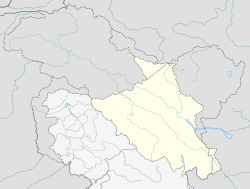world.wikisort.org - India
Bogdang (Bukdang, Beyoqdan,[1] Biagdangdo,[2] ) is a village in the Leh district of Ladakh, India.[3] It is located in Nubra tehsil.
Bogdang
, Beyoqdan | |
|---|---|
Village | |
 Bogdang Location in Ladakh, India  Bogdang Bogdang (India) | |
| Coordinates: 34.803409°N 77.041481°E | |
| Country | India |
| Union Territory | Ladakh |
| District | Leh |
| Tehsil | Nubra |
| Population (2011) | |
| • Total | 1,988 |
| Time zone | UTC+5:30 (IST) |
| PIN | 194401 |
| Census code | 915 |
Location
Bogdang is located in the Shyok River valley after it narrows near Yagulung, the portion sometimes called the Chorbat Valley, distinguishing it from the "Lower Nubra" (the wider Shyok Valley).[4] During the First Kashmir War of 1947–48, the Gilgit Scouts that invaded the region were pushed beyond the village, and the cease-fire line was set at Chalunka, the next village on the Shyok River.[5] Thus Bogdang was the northernmost village of Ladakh on the Shyok River until 1971.
In the Indo-Pakistani War of 1971, the Ladakh Scouts conquered Chalunka, Turtuk Thang Tyakshi small villages of the Chorbat Valley, making Bogdang safely in the interior of Indian-administered Kashmir.
Demographics
According to the 2011 census of India, Bogdang has 272 households. The effective literacy rate (i.e. the literacy rate of population excluding children aged 6 and below) is 64.89%.[6]
| Total | Male | Female | |
|---|---|---|---|
| Population | 1988 | 1005 | 983 |
| Children aged below 6 years | 450 | 242 | 208 |
| Scheduled caste | 0 | 0 | 0 |
| Scheduled tribe | 1975 | 998 | 977 |
| Literates | 998 | 631 | 367 |
| Workers (all) | 782 | 366 | 416 |
| Main workers (total) | 165 | 155 | 10 |
| Main workers: Cultivators | 0 | 0 | 0 |
| Main workers: Agricultural labourers | 1 | 1 | 0 |
| Main workers: Household industry workers | 2 | 2 | 0 |
| Main workers: Other | 162 | 152 | 10 |
| Marginal workers (total) | 617 | 211 | 406 |
| Marginal workers: Cultivators | 572 | 173 | 399 |
| Marginal workers: Agricultural labourers | 3 | 0 | 3 |
| Marginal workers: Household industry workers | 0 | 0 | 0 |
| Marginal workers: Others | 42 | 38 | 4 |
| Non-workers | 1206 | 639 | 567 |
References
- "Chorbat Valley: The Picturesque Valley of Gilgit Baltistan, Pakistan". Pakistan Source. 8 April 2016. Archived from the original on 23 October 2016.
- Longstaff, Glacier Exploration in the Eastern Karakoram (1910), p. 638.
- "Blockwise Village Amenity Directory" (PDF). Ladakh Autonomous Hill Development Council. Archived from the original (PDF) on 9 September 2016. Retrieved 23 July 2015.
- Longstaff, Glacier Exploration in the Eastern Karakoram (1910), p. 648.
- Rao, K. V. Krishna (1991), Prepare Or Perish: A Study of National Security, Lancer Publishers, p. 472, item (d), ISBN 978-81-7212-001-6
- "Leh district census". 2011 Census of India. Directorate of Census Operations. Retrieved 23 July 2015.
Bibliography
- Longstaff, T. G. (June 1910), "Glacier Exploration in the Eastern Karakoram", The Geographical Journal, The Royal Geographical Society, 35 (6): 622–653, doi:10.2307/1777235, JSTOR 1777235
Другой контент может иметь иную лицензию. Перед использованием материалов сайта WikiSort.org внимательно изучите правила лицензирования конкретных элементов наполнения сайта.
WikiSort.org - проект по пересортировке и дополнению контента Википедии